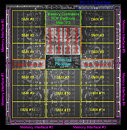Thursday, May 17th 2012

GK110 Packs 2880 CUDA Cores, 384-bit Memory Interface: Die-Shot
With its competition checked thanks to good performance by its GK104 silicon, NVIDIA was bold enough to release die-shots of its GK110 silicon, which made its market entry as the Tesla K20 GPU-compute accelerator. This opened flood-gates of speculation surrounding minute details of the new chip, from various sources. We found one of these most plausible, by Beyond3D community member "fellix". The source of the image appears to have charted out component layout of the chip by some pattern recognition and educated guesswork.
It identifies the the 7.1 billion transistor GK110 silicon to have 15 streaming multiprocessors (SMX). A little earlier this week, sources close to NVIDIA confirmed the SMX count to TechPowerUp. NVIDIA revealed that the chip will retain the SMX design of GK104, in which each of these holds 192 CUDA cores. Going by that, GK110 has a total of 2880 cores. Blocks of SMX units surround a centrally-located command processor, along with six setup pipelines, and a portion holding the ROPs and memory controllers. There are a total of six GDDR5 PHYs, which could amount to a 384-bit wide memory interface. The chip talks to the rest of the system over PCI-Express 3.0.
Source:
Beyond3D Forum
It identifies the the 7.1 billion transistor GK110 silicon to have 15 streaming multiprocessors (SMX). A little earlier this week, sources close to NVIDIA confirmed the SMX count to TechPowerUp. NVIDIA revealed that the chip will retain the SMX design of GK104, in which each of these holds 192 CUDA cores. Going by that, GK110 has a total of 2880 cores. Blocks of SMX units surround a centrally-located command processor, along with six setup pipelines, and a portion holding the ROPs and memory controllers. There are a total of six GDDR5 PHYs, which could amount to a 384-bit wide memory interface. The chip talks to the rest of the system over PCI-Express 3.0.

65 Comments on GK110 Packs 2880 CUDA Cores, 384-bit Memory Interface: Die-Shot
Otherwise I'm not seeing the shame in it. Before Fermi memory addressing was 32bit (storing 64bit values in multiple 32bit address - now that is far from optimal!). With 64bit addressing in Fermi and newer, seems like each access would occur on 1 (possibly 2?) of it's 6 memory controllers. There's not enough nitty gritty information in the GK110 whitepaper nor understanding on my part to say anything definitive about how their memory management works.
And in reality, suboptimal or not, I'll take 384bit over 320bit over 256bit. If they want to give me 448bit or 512bit, that would awesome too. Well, awesome in theory. I still haven't been able to work up the case for the company to buy Teslas for my servers :D
Ask yourself: WTH would buy industrial VGA for home use with price at 4000+ USD/Euro? Nobody cares about games with Teslas. Don't compare GeForce with Tesla or Quadro. Like comparing old rusty bike to Ferrari or SLR Mercedes.
Maybe you could come over and show us your fancy car and stuff, and bring us icecream and other treats huh?
I'm doubtful we'll see a GK110 based gaming card this generation, seems GK110 will be the compute (read: Tesla) card.
i would say this spec of GK110 chip wont hit consumer cards until the 7xx imho
Anyway I think it all depends on AMD/ATI 89xx series and how early they will launch it.
Nvidia may just continue using smaller chips on their Geforce lineup because they are less likely to encounter yield issues and huge costs linked to very big chip designs.
This PDF will help with the speculation's and such. Apparently there are 16 Texture Units per SMX 240 total! The L2 Cache is double so one can only speculate double the ROP's (128). The core clock and memory clock is still unknown, but the data compiling on this monstrosity is staggering! I would gladly pay $600 or $700 on a chip of this magnitude, well if I needed that much power my 7870 is amazing all by it's self.
Few companies take the time and money to invest to be self reliant if your not you get in line along with the rest of them.
Nvidia Investors meeting was today
The Tesla will be available in Q4 2012. No mention of the GeForce line.